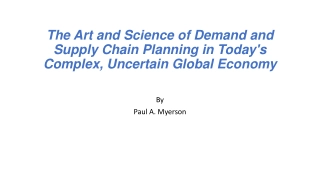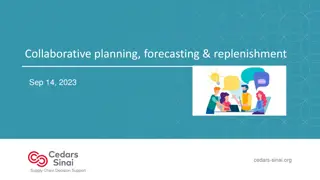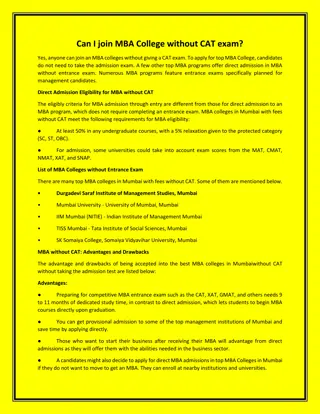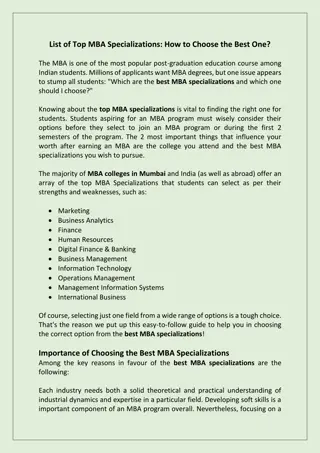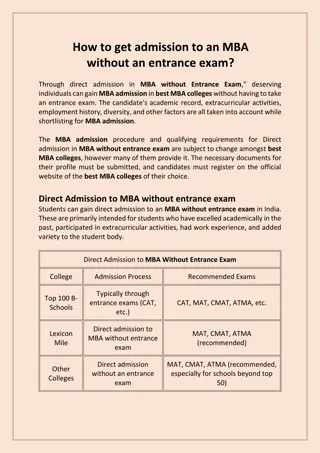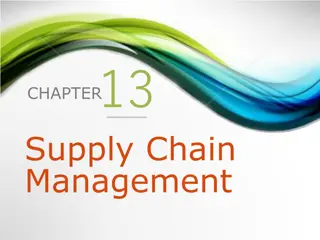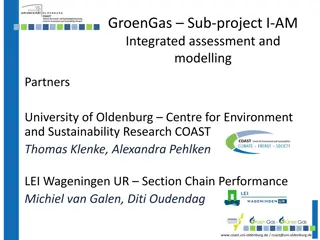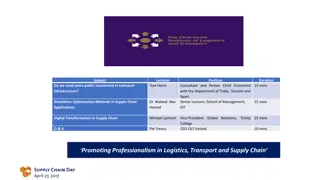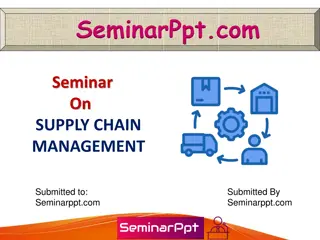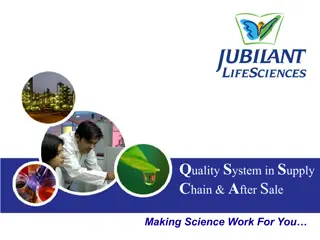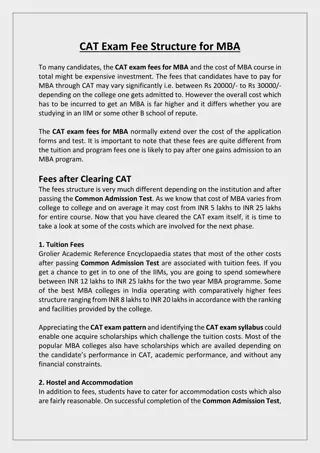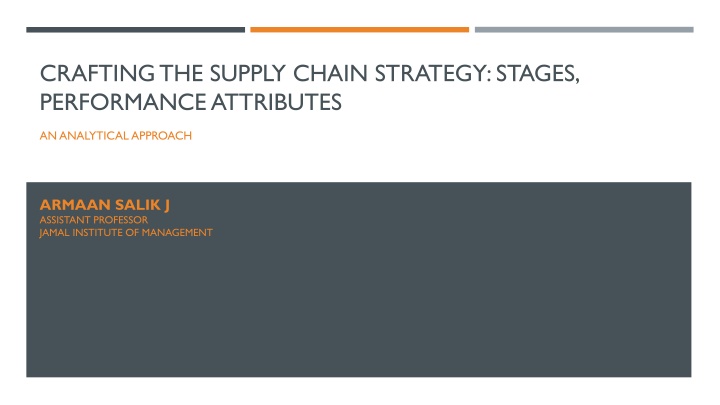
Crafting a Robust Supply Chain Strategy for Business Success
Explore the key stages, performance attributes, and importance of supply chain strategy in achieving business goals. Learn about demand forecasting, supplier management, inventory optimization, logistics, risk mitigation, and more.
Download Presentation

Please find below an Image/Link to download the presentation.
The content on the website is provided AS IS for your information and personal use only. It may not be sold, licensed, or shared on other websites without obtaining consent from the author. If you encounter any issues during the download, it is possible that the publisher has removed the file from their server.
You are allowed to download the files provided on this website for personal or commercial use, subject to the condition that they are used lawfully. All files are the property of their respective owners.
The content on the website is provided AS IS for your information and personal use only. It may not be sold, licensed, or shared on other websites without obtaining consent from the author.
E N D
Presentation Transcript
CRAFTING THE SUPPLY CHAIN STRATEGY: STAGES, PERFORMANCE ATTRIBUTES AN ANALYTICAL APPROACH ARMAAN SALIK J ASSISTANT PROFESSOR JAMAL INSTITUTE OF MANAGEMENT
INTRODUCTION Definition of Supply Chain Strategy: A comprehensive plan that defines how a company will manage its supply chain to achieve business goals. Importance in Business Operations: Ensures efficiency, cost reduction, and customer satisfaction. Objectives of the Presentation: Explain the key elements of supply chain strategy. Discuss the different stages involved in crafting a strategy. Highlight essential performance attributes. Provide real-world insights and recommendations.
KEY ELEMENTS OF A SUPPLY CHAIN STRATEGY Demand Forecasting: Utilizing data analytics to predict future demand and align supply chain activities accordingly. Supplier Management: Establishing strong relationships with suppliers to ensure reliability and quality. Inventory Optimization: Balancing inventory levels to prevent stockouts or overstocking. Logistics and Distribution: Ensuring timely delivery of goods through an efficient transportation network. Risk Mitigation: Identifying potential risks and developing contingency plans.
STAGES OF CRAFTING A SUPPLY CHAIN STRATEGY Stage 1: Understanding Business Goals Aligning supply chain objectives with the company's overall business strategy. Identifying key performance indicators (KPIs) to measure success. Stage 2: Analyzing Market and Demand Conducting market research to understand customer needs and expectations. Utilizing demand forecasting techniques for informed decision-making. Stage 3: Designing Supply Chain Network Structuring the supply chain to optimize efficiency and minimize costs. Deciding on key factors such as warehouse locations and transportation methods.
STAGES OF CRAFTING A SUPPLY CHAIN STRATEGY Stage 4: Implementing Technology and Automation Integrating advanced technologies like AI, IoT, and blockchain for supply chain transparency. Automating key processes to enhance operational efficiency. Stage 5: Continuous Monitoring and Improvement Regularly assessing performance metrics to identify areas for improvement. Implementing feedback loops and agile methodologies for ongoing optimization.
SUPPLY CHAIN PERFORMANCE ATTRIBUTES Efficiency: Measures how well resources are utilized to achieve desired outcomes with minimal waste. Responsiveness: The ability to quickly adapt to market changes and customer demands. Resilience: Capacity to recover from disruptions and maintain operations. Agility: Flexibility to adjust supply chain activities in response to dynamic business environments. Sustainability: Implementing environmentally friendly practices and reducing carbon footprints.
CHALLENGES IN SUPPLY CHAIN STRATEGY Supply-Demand Mismatches: Inaccurate forecasting leading to either excess inventory or stock shortages. Inefficient Inventory Management: Poor visibility and stock level control leads to waste. Disruptions in Logistics: Transportation delays, supply chain bottlenecks, and geopolitical risks affecting operations. Lack of coordination across departments: Siloed decision-making leads to inefficiencies and misaligned objectives.
STRATEGIES FOR OPTIMIZATION Implementation of AI and Predictive Analytics: Leveraging data-driven insights to improve forecasting accuracy. Strengthening Supplier Relationships: Establishing long-term partnerships for better collaboration and reliability. Advanced Inventory Management Systems: Using RFID and IoT to track inventory in real time and reduce inefficiencies. Real-time Data Monitoring: Implementing dashboards and analytics tools to ensure proactive decision-making.
RECOMMENDATIONS FOR FUTURE ENHANCEMENTS Regular Supply Chain Assessments: Conducting periodic evaluations to identify inefficiencies and opportunities. Enhanced Interdepartmental Collaboration: Encouraging cross-functional teamwork for better alignment of goals. Investment in Training and Development: Providing employees with the necessary skills to adapt to evolving supply chain trends. Adoption of Digital Supply Chain Tools: Integrating ERP, AI, and blockchain to enhance supply chain transparency and efficiency.
CASE STUDY - IHI INCORPORATED Company Overview: IHI Incorporated specializes in turbocharger supply and repair for ocean vessels and power plants. Operates within a highly competitive industry requiring efficient supply chain management. Supply Chain and Inventory Management Challenges: Issues related to demand forecasting leading to stockouts or overstocking. Need for better tracking and coordination between departments. Inefficiencies in supplier collaboration and logistics.
KEY FINDINGS: Strong correlation between supply chain management and inventory efficiency. Employees emphasized the need for accurate demand forecasting to ensure product availability. Supplier performance audits and logistics streamlining were recommended to reduce lead times.
PERFORMANCE ASSESSMENT: Demand Forecasting: Rated as needing improvement, with inconsistencies in predicting customer demand. Inventory Management: Required enhanced tracking and real-time visibility of stock levels. Supplier Collaboration: Identified as an area requiring structured contracts and performance reviews.
PROPOSED SOLUTIONS: Implement AI-driven demand forecasting to optimize inventory levels. Enhance interdepartmental collaboration through integrated ERP systems. Strengthen supplier relationships via performance-based contracts. Invest in real-time tracking systems to monitor inventory flow.
EXPECTED OUTCOMES: Reduction in stock discrepancies and improved order fulfillment rates. Enhanced efficiency in logistics, reducing delays and increasing cost-effectiveness. Better alignment of supply chain strategy with overall business objectives.
REFERENCE Rodriguez, Joel Mark, An Analysis of the Supply Chain Management: Crafting a Plan for Supply chain and Inventory Management (April 08, 2024). International Journal of Science, Engineering and Technology, International Journal of Science, Engineering and Technology, volume 12, issue 2, 2024 [10.61463/ijset.vol.12.issue2.132], Available at SSRN: https://ssrn.com/abstract=4801272 or http://dx.doi.org/10.61463/ijset.vol.12.issue2.132

